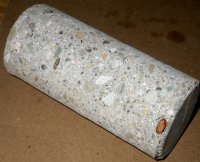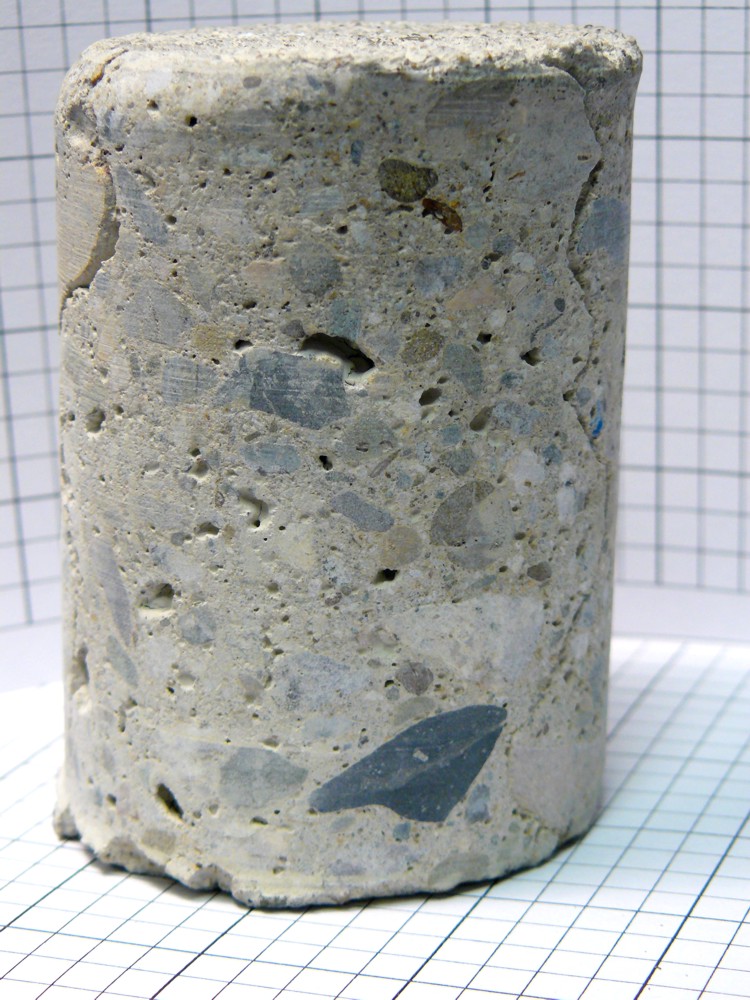|
Specified Strength
of Cylinders vs. Cores
 On a recent project the
concrete column strengths for one pour fell short of the specified 4000psi.
Cores were taken in accordance with IBC 2006 Section 1905.6.6 and ACI 318
Section 5.6.5. Due to project schedules and forming techniques cores were taken
vertically from the column tops. Subsequent strength testing indicated
acceptable results and the project continued with only this small blip.
Afterwards, our client questioned our field-testing. They claimed that if the
core testing results met the requirements of the Code, the cylinder testing was
obviously incorrect and therefore refused to pay for the coring. What is the
relationship between the strength indicated by the test cylinders compared with
the strength of the concrete in the structure?
 Test specimens (cylinders) are made,
cured and tested under certain standard conditions that are usually appreciably
different from the conditions existing in the structure. The value of
field-cast test specimens is that they give a measure of the strength
potential (they evaluate the materials and mix as supplied by the producer,
to ascertain the concrete meets project specifications).Test specimens are not
intended to yield an exact strength of the concrete in the structure, and the actual
strength of the concrete in the structure can be appreciably different.
Besides variable environmental site conditions and curing, other variables
between test specimens and the concrete in the structure include variations of
mix components, water content, size, and shape of the structure, workmanship,
degree of consolidation, possible presence of defects such as rock pockets,
restraint, and combinations of loading in the structure. It is because of these
unknowns that the Structural Engineer must consider a factor of safety when the
structure is designed.
Variations in cylinder strengths are not
always reflective of a problem in the structure. For instance if three sets of
specimens are made from one day’s concrete placement and maintained under
identical conditions throughout the test duration, there is no assurance they
will all fail at the same strength when they are tested at the same age. In
fact, each one will almost always break at a different strength. These are
normal variations, and they should be expected.
Cored specimens are usually obtained days
or weeks, even months, after the laboratory testing of cylinders. This
additional time must be taken into account when comparing cylinder and core
test results. In addition, cored specimens are tested in a dry or moist
condition, but rarely in the saturated condition similar to test cylinders. It
is well documented that dry specimens have a higher compressive strength than
saturated specimens.
We do know that there are variations in
the strength of the structure that are not caused by basic variations in the
concrete itself. For example when cores are taken from a column, the cores from
the upper portion of the column invariably indicate lower strength than the
cores from the bottom portion of the column. The reason is that the concrete
near the bottom was compacted by static hydraulic head of the concrete being
worked above, yet there was no change in mix or materials.
Jump to Top
Establishing Concrete Strengths with Core Tests at 85%
 I’m investigating an older
concrete building and would like to use ACI 318 Section 5.6.5 to confirm the
existing concrete strengths. Can you outline a procedure for specifying the
work and explain the rule of 85%?

 A nondestructive test
meth-od, such as probe pene-tration, impact hammer or ultrasonic pulse velocity
may be useful in surveying structural members for areas of lower strength
concrete. From this preliminary viewpoint use ASTM C823-00 “Standard
Practice for Examination and Sampling of Hardened Concrete on Construction”
to formulate specific areas of investigation. The selected areas then can be
specified for investigation for concrete strength according to ASTM C42-04 “Standard
Test Method for Obtaining and Testing Drilled Cores and Sawed Beams of Concrete”.
Section 3.2 States “Generally, test specimens are obtained when doubt exists
about the in-place concrete quality” and “use of this method is to provide
strength information on older structures.”
According to International Building Code IBC Section
1905.6.5.2, three cores will be taken for each strength test. And Section
1905.6.5.4 states, “the average of three cores is equal to at least 85% of f’c”.
The rule of 85% can be best explained by ASTM C42-04
Section 3.5 “There is no universal
relationship between the compressive strength of a core and the corresponding
compressive strength of standard-cured molded cylinders. The relationship is
affected by many factors such as the strength level of the concrete, the
in-place temperature and moisture history, and the strength gain
characteristics of the concrete. Historically, it has been assumed that core
strengths are generally 85 % of the corresponding standard-cured cylinder
strengths, but this is not applicable to all situations.”
The commentary of ACI 318 Section R5.6.5 also states
“Core tests having an average of 85% of the specified strengths are realistic.
To expect core tests to be equal to f’c is not realistic, since
differences in the size of specimens, conditions of obtaining samples, and
procedures for curing, do not permit equal values to be obtained.”
NOTE: According to ACI 214.4R-03 “Guide for
Obtaining Cores & Interpreting Compressive Strength Results” the
preceding method is NOT an option when evaluating for structural capacity
For further information ASTM references Neville, A.,
“Core Tests: Easy to perform, Not easy to Interpret,” Concrete
International, Vol.23 No. 11 November 2001, pp. 59-68.
Jump to Top
Water-Cement Ratio vs. Strength
 Many published articles relate how
changing the water-cement ratio has a large effect on concrete strength. Is
there a simple explanation for this effect?

 In
general, there exists a fundamental inverse relationship between porosity and
strength of solids. This strength-porosity relationship is applicable to a wide
range of materials, such as iron, stainless steel and granite. Think of examining a concrete core, which
exhibits voids created by a lack of consolidation. You can imagine, why with a
lack of internal structure, the compressive strength would be lower than
expected. On a much smaller scale, there is a theoretical volume of water
(based on curing conditions) required to hydrate a given volume of cement. Once
you have added more than that amount it creates capillary porosity (i.e.
microscopic cavities or voids). The higher the water-cement ratio the more
porous the weaker the strength. Generally, to maximize strength and durability,
the water-cement ratio should be the lowest possible to hydrate the cement
while maintaining its workability.
Jump to Top
Low Concrete Strengths on California School Projects
 We have a school
project in California where the specified concrete strength is 4000 psi at
28-days. On one specific pour the following strengths were obtained: 7-day strength = 2780 psi
28-day strength =3890 psi (average of 2 cylinders)
56-day strength = 4150 psi (1 cylinder)
Do you report the results as meeting the requirements of the DSA
approved document?
 California Building Code,
Title 24, Part 2, Chapter 1905A.6.3 Strength Test Specimens states “Strength test acceptance criteria shall
comply with the provisions of ACI 318, Section 5.6.3.” Section 5.6.3.3 notes “Concrete shall be considered satisfactory if
both of the following requirements are met:
A) Every arithmetic average of any three
consecutive strength tests equals or exceeds f’c.
B) No strength test falls below f’c by more than 500 psi when f’c is 5000 psi or less.”
Using this guideline, the results above would be
acceptable if the 28-day cylinders, when averaged with three consecutive strength
test results on the project are equal to or greater than 4000 PSI. This assumes
that no individual test was less than 3500 PSI.
The Division of the State Architect holds a
different position regarding low strength concrete test results. DSA believes that the LEA approved laboratory
should report all failing test results immediately as a non-conformance. It is then up to the design professional and
DSA to determine a corrective action plan.
If an approved stamped change order is not received from DSA, the
failing results should be reported on your laboratory verified report, DSA Form
291. In the 2007 California
Administrative Code, Title 24, Part 1, section 4-335b, Performance of Tests, it
states, “Where a sample has failed to
pass the required tests the architect or engineer, subject to the approval of
DSA, may permit retest of the sampled material.” Section 4-335d, Test Reports also notes “Reports of test results of materials not
found to be in compliance with the requirements of the plans and specifications
shall be forwarded immediately to DSA, the architect, the structural engineer,
and the project inspector.”
So although the 56-day strength test met the 28-day
f’c requirements, DSA does not
consider the results to be valid. The
test report must be distributed noting, “the
results did not meet the requirements of the DSA approved documents.” There are no provisions in the California
Building/Administrative Code, Title 24 that allow the use of a 56-day test
result in lieu of the required 28-day test result. However a 56-day test result may be
useful to the design professional and DSA in arriving at a corrective action
plan.
Reference Documents
2007 California Administrative Code, California Code
of Regulations, Title 24, Part 1
2007 California Building Code, California Code of
Regulations, Title 24, Part 2, Volume 2
Building Code Requirements for Structural Concrete
(ACI 318-08) and Commentary
Jump to Top
Mortar Testing by Cylinders or Cubes
 When testing for compressive
strength of mortar the 2007 CBC (California Building Code) specifies “Average
Compressive Strength at 28 days” as noted in Table 2103A.8(2). Is this strength
tested and computed by cylinders or cubes?
 Mortar testing is normally
required for schools and hospitals, hence your reference to table 2103A.8(2) in
2007 CBC. In the title block of the reference table under Average Compressive
Strength there is a small b notation, referring the note at the bottom, which
reads “b. Average of three 2-inch cubes of laboratory-prepared mortar, in
accordance with ASTM C270.”So, the specified strength is based on 2-inch
cubes prepared in the laboratory.
Section 2105A.5 specifies “Test specimens for mortar
shall be made as set forth in ASTM C1586”. As we were informed in FAQ 10.043,
C1586 refers us to C780 Annexes A.7, which describes specimens made as
cylinders or cubes.
A further clarification is found in “Reinforced
Concrete Masonry Construction Inspector’s Handbook” Fourth Edition, which
indicates “The 2-inch cube is typically used for laboratory prepared mortar
while the 2 inch x 4 inch cylindrical specimen is used for field cast
mortar”. To obtain an equivalency of a
2” x 4” cylinder field test specimen to a 2” cube specimen, divide the
compression test result of the cylinder specimen by 0.85. The factor of 0.85 is
the normal correction h/d found in ASTM C780 5.2.6 Note 3.
When testing for compressive strength of mortar in
the field you could use either 2-inch cube molds or 2 inch x 4 inch cylindrical
molds. The typical standard of practice that most testing laboratories follow
is to test field mortar by preparing specimens in a 2 inch x 4 inch cylindrical
mold and if required showing a correction factor when the specimens are tested
depending on which specimen, cubes or cylinders, was specified for the project. |





